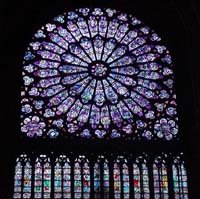The Cathédral Notre-Dame de Paris is considered by many to be the most beautiful and the most famous monument of the Ile de la Cité.
Preceeded by a Gallo-Roman temple to Jupiter, a Christian basilica, and a Romanesque church, construction of Notre-Dame de Paris began in 1163 during the reign of Louis VII. Pope Alexander III laid the foundation stone. The idea to replace the Romanesque church occupying the site - the Cathedral of St. Etienne (founded by Childebert in 528) - was that of Bishop Maurice de Sully (who died in 1196). Construction was completed roughly 200 years later in about 1345.
During the reign of Louis XIV and Louis XV, at the end of the 17th century, the cathedral underwent major alterations as part of an ongoing attempt to modernise cathedrals throughout Europe. Tombs and stained glass windows were destroyed. The North and South Rose Windows were spared this fate, however. These two windows of Notre Dame were built between 1250 and 1260, and were
 designed in the style of the High Gothic period. This is evident by how they sit flush with the wall rather than being recessed, unlike the rose window on the Western Façade which was built during the Early Gothic period. The rose window on the South wall depicts the "Triumph of Christ" along with scenes from the New Testament. These rose windows are notable for being one of the few stained glass windows in the cathedral, and indeed in all of Europe, that still have their original glasswork.
designed in the style of the High Gothic period. This is evident by how they sit flush with the wall rather than being recessed, unlike the rose window on the Western Façade which was built during the Early Gothic period. The rose window on the South wall depicts the "Triumph of Christ" along with scenes from the New Testament. These rose windows are notable for being one of the few stained glass windows in the cathedral, and indeed in all of Europe, that still have their original glasswork.In 1793 during the French Revolution, the cathedral was turned into a "Temple to Reason" and many of its treasures were destroyed or stolen. Several sculptures were smashed and destroyed, and for a time Lady Liberty replaced the Virgin Mary on several altars. The cathedral's great bells managed to avoid being melted down, but the cathedral was used as a warehouse for the storage of food.
A restoration program was initiated in 1845, overseen by architects Jean-Baptiste-Antoine Lassus and Eugène Viollet-le-Duc. The restoration lasted 23 years and included the construction of a flèche (a type of spire) as well as the addition of the chimeras on the Galerie des Chimères.
In 1939, it was feared that German bombers could destroy the stained glass windows. As a result, on September 13, 1939, they were removed. They were restored at the end of the war.
In 1991, a major program of maintenance and restoration was initiated, which was intended to last 10 years but is still in progress as of 2005, the cleaning and restoration of old sculptures being an exceedingly delicate matter.
Sources: Les Cars Rouges, Paris Pages: Notre Dame, Wikipedia: Notre Dame de Paris









































No comments:
Post a Comment